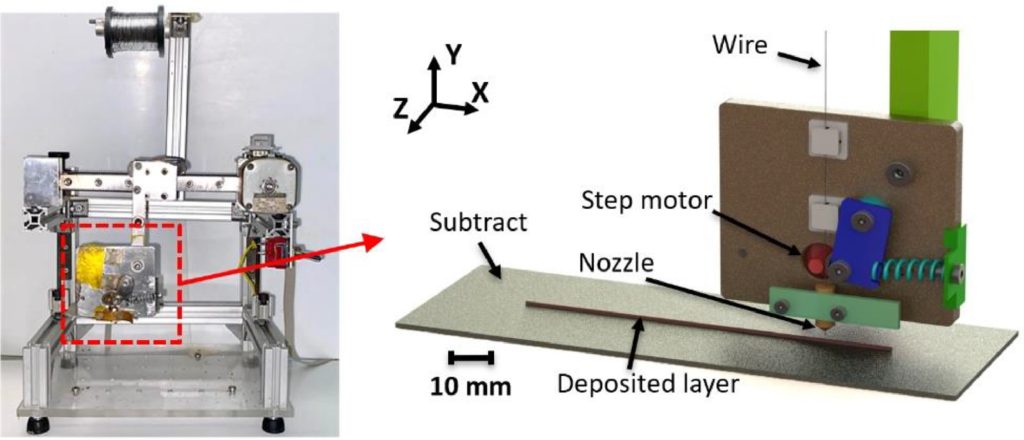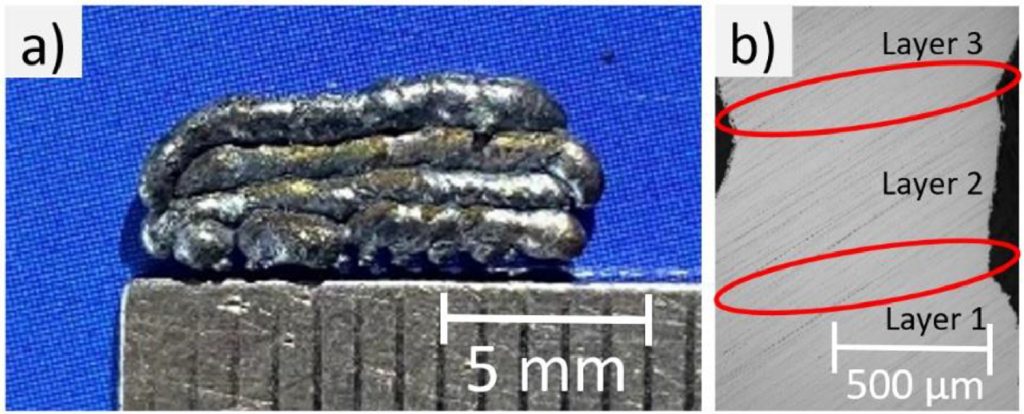3D Printing Industry is currently seeking feedback on resin 3D printing. Send your insights now and take the Spotlight on Resin 3D Printing Survey.
A team of researchers from NOVA University Lisbon has developed a new form of Wire Arc Additive Manufacturing (WAAM) that’s specifically designed for small parts and fine feature details.
Named µ-WAAM, the high-precision 3D printing technology utilizes metal wire materials with a diameter of just 250µm. For context, conventional WAAM typically uses wire diameters of above 1mm. It aims to offer both precision and print speed, combining the resolution of powder bed fusion (PBF) with the deposition rates and material efficiency of traditional WAAM.
According to the NOVA researchers, the new µ-WAAM approach is particularly well suited to the fabrication of thin walls and other intricate structures that large-scale WAAM would struggle with.

PBF versus WAAM 3D printing
If you’re looking for smaller-scale metal components, PBF is the 3D printing technology to go for. The approach leverages a laser or electron beam to melt and fuse powdered feedstock in a powder bed, recoating and reprinting after each layer to fabricate solid 3D parts. Owing to the use of a spot laser, PBF offers high geometric accuracy, but is held back by low deposition rates and high powder waste.
On the other hand, those seeking larger part production might find it useful to opt for a wire-feed directed energy deposition (DED) process instead. While it does suffer from poor printing resolution, WAAM boasts relatively high material deposition rates, making it great for large part applications in industries such as maritime.

The µ-WAAM 3D printer
To combine the best of both worlds, the NOVA researchers developed a custom µ-WAAM electric arc torch with a small gantry system. Much like a run-of-the-mill FFF machine, the µ-WAAM printer is based on the cartesian coordinate system and utilizes linear bearings and conventional stepper motors.
According to the team, the wire feed device was inspired by the filament extruders found in FFF 3D printers. One drive gear is actuated by a stepper motor compressed under a radial bearing.
In order to establish the electric contact with the wire feed, the team used a 0.3mm brass nozzle. Additionally, a standard 12V/100Ah battery was used as a power source. In this case, a battery was required because conventional welding sources simply would not provide the adequate I-V characteristics to generate such a small welding arc. The NOVA researchers even integrated an argon-based shielding gas to avoid process-induced defects such as pores, while protecting the wire material against oxidation.
So how did it stack up? To test the µ-WAAM 3D printer, the team had it print out a number of thin wall structures using steel wire. Where PBF can only achieve build rates of around 2g/min, µ-WAAM clocked in at up to 5g/min. This still doesn’t hold a candle up to the deposition rate of conventional WAAM, which can be around 18.5g/min, but is impressive given the size of the custom system.
When it comes to dimensional precision, WAAM may only deliver accuracies of ±0.7mm, which is why extensive post-processing is necessary to achieve high-quality surface finishes. On the other hand, the µ-WAAM process managed to achieve a dimensional precision of less than 0.3mm. Again, this isn’t as precise as PBF (±0.04mm), but provides a nice jack-of-all-trades middle ground between the two conventional technologies.
Ultimately, the work successfully validated a new variant of WAAM, scaling the technology down to suit finer feature details and thin walls. The µ-WAAM approach is by no means perfect, but it bridges the benefits of both PBF and WAAM, addressing some of the pain points of each.
Further details of the study can be found in the paper titled ‘Micro Wire and Arc Additive Manufacturing (µ-WAAM)’.

Last month in a similar study, engineers at the US-based California State University, Los Angeles and Turkish Eskisehir Osmangazi University developed a low-cost WAAM 3D printer that can be built for just $1,000. By integrating gas tungsten arc welding (GTAW) technology into an FDM-like gantry setup, the researchers were able to create a machine that doesn’t rely on complex robotic arms, allowing them to keep it affordable and open-source.
In industry, MX3D, a developer of metal WAAM technology, recently unveiled its new partly 3D printed ‘WAAM Clamp’. The hybrid industrial part is an example of a pipeline clamp, a component used to seal high-pressure leaks in the chemical and oil and gas sectors. Weighing in at 87kg (30kg of which was 3D printed), the WAAM Clamp took 45 hours to manufacture.
Subscribe to the 3D Printing Industry newsletter for the latest news in additive manufacturing. You can also stay connected by following us on Twitter, liking us on Facebook, and tuning into the 3D Printing Industry YouTube Channel.
Looking for a career in additive manufacturing? Visit 3D Printing Jobs for a selection of roles in the industry.
Featured image shows large parts 3D printed via WAAM. Photo via WAAM3D Ltd.


